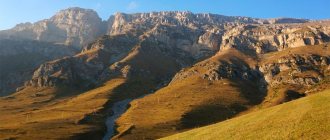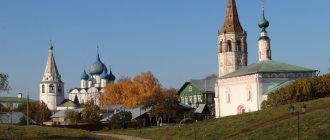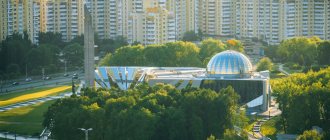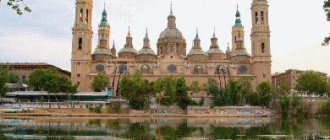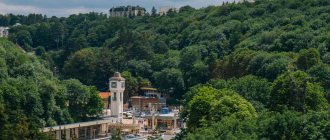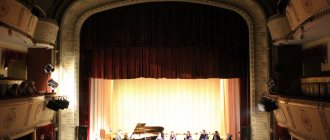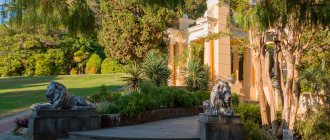The city of Velikiye Luki turned out to be very ancient, because the date of its foundation is considered to be 1166, as evidenced by numerous photos and attractions that have been attracting visitors for decades. This ordinary provincial city has something to please, because it has a great history, and besides, in ancient times it was called the “atrium of Moscow.”
Today I’ll tell you about what’s worth seeing in Velikiye Luki and where to spend a family vacation.
Obelisk of Glory
On the ramparts of the old fortress near the Lovat River there is a tall stone memorial obelisk about the fallen Soviet soldiers who defended the approaches to the city. At the base of the monument there is a capsule containing the ashes of an unknown soldier. Next to the stele are the mass graves of the multinational Soviet army.
Cultural and historical sights of Velikiye Luki with descriptions and photos
Looking into history, you understand why so few historical sights of the city remain. Since Velikiye Luki had either a border or militarily strategically important location, not a single war passed the city by, and, as a result, it was constantly subject to devastation and destruction. And although among the attractions of the modern city of Velikiye Luki there are few ancient historical objects and only their photographs have been preserved, there is something to see in the city.
Architecture of Velikiye Luki
One of the ancient architectural structures in the city is the Velikolukskaya Fortress . This wall protected the inhabitants of the city from the Lithuanians and Polovtsians living in the area where modern Belarus is located. According to the chronicles, the fortress was built in the 12th-13th centuries, but already at the onset of the 18th century, it was completely rebuilt, making it a bastion, by order of Peter I.
To date, the Velikolukskaya Fortress has preserved:
- 6 bastions and ramparts, which have settled slightly and are 15 m high;
- architecture;
- walls whose asphalt paths are convenient for walking;
- remains of a vaulted main gate;
- part of the buildings inside the fortress;
- ruins of the fortification.
Upon arrival in the city, I was impressed by the building of the Velikiye Luki Railway Station , opened in 1901 upon completion of the construction of the Vindava Railway. In the beige buildings, a strict architectural style is noticeable, which goes well with the trees planted throughout the territory and with flower beds.
City monuments
I really liked the T-34 tank monument , the grand opening of which took place on May 9, 1974, on the 30th anniversary of the liberation of the city. The monument demonstrates respect for the memory of all tank crews killed in battles. The design of the monument was implemented by local architect V.D. Sokolovsky, who created a reinforced concrete pedestal with a tank erected. The front side of the pedestal has an inscription describing the period of the war and memorial inscriptions dedicated to the fallen tank crews.
A completely expected monument was the monument to Lenin , ordered from the sculptor Yatsino, the production of which was carried out by the Mytishchensky Art Casting Plant. Thanks to numerous requests from the enterprise and public organizations of the railway junction, the local authorities agreed to install a monument to Lenin on Station Square. However, in 1966 he demanded reconstruction, which was excellently carried out by the team of Velikiye Luki art workshops. Now the monument is surrounded by beautiful trees and bright flower beds.
The city fortress pleased us with another monument - the Obelisk of Glory , made of brown stone. Its height reaches 26 meters, and, given that it is installed on a decent hill, the monument can be seen from anywhere in the city. The author and sculptor of the Obelisk of Glory was Mark Poort. He presented the monument with a semicircular pedestal, decorated with powerful pylons carrying an upward-pointing granite column, which is crowned with a five-pointed three-meter star. The memorial plate at the base has an urn with the ashes of an unknown soldier and mass graves.
Velikiye Luki Museums
- It was a pleasure to visit the memorial museum-estate of Sofia Kovalevskaya , which is located 35-40 kilometers from Velikie Luki. The museum is represented by a large and beautiful building of the 19th century with a surprisingly preserved outbuilding from the same century. Previously, they were connected by a gallery, which was destroyed during the war. In those days, the estate was quite rich and prosperous, surrounded by a wonderful park. Not much remains of what has survived. Today, this is the only museum in the world dedicated to this woman mathematician; its area is 50 square meters. m. Here you can get acquainted with Kovalevskaya’s books, her original autographs, including the manuscript of the novel “Nihilist,” wardrobe items and personal belongings.
- The house-museum , where personal belongings, original documents and scientific works, the scientist’s awards, and valuable gifts for the holidays, helped me learn a lot about the life of the famous academician Vinogradov Thanks to the surviving significant part of his home library, it is clear that he was a fairly erudite person. The museum received most of the exhibits as a gift from the Mathematical Institute. V. A. Steklov, which was led by the scientist for a long time. The total number of exhibits in the museum is over 6,000, which means they help to present Vinogradov’s lifestyle, his interests and hobbies.
- And how can you do without visiting the city’s Local History Museum , opened in 1919 . Most of the exhibition was lost during the Great Patriotic War and began to be restored only in the 50s of the 20th century. The museum building is a typical example of Soviet architecture. The museum has three halls: one has a permanent exhibition, the other two are temporary. There are about 30 thousand items in the museum's collections, and all of them perfectly illustrate the history of the city. Among the exhibits are archaeological finds, ancient coins, weapons, awards, a soldier's dugout, dioramas of a war-torn city and a fortress wall.
Museum-Estate of Sofia Kovalevskaya
The most outstanding exhibition is “The Battle Glory of the Velikoluchans,” which tells the story of the true heroism of local residents during the Second World War.
If possible, take a look at
the Museum of the famous Russian composer Mussorgsky in the village of Naumovo.
Religious buildings of the city
I was surprised by the beauty of the Church of the Kazan Icon of the Mother of God , founded in 1821 at the expense of the townspeople. The brick building was erected on the city cemetery in the style of Baroque architecture in a design that at the same time is very similar to the earlier Church of the Ascension (now the Ascension Cathedral). Initially, there were three altars in the church, but only one has survived - the altar of All Saints. However, inside the church I was pleased with the wall paintings created at the beginning of the 20th century and the completely preserved iconostasis. In the 20s of the 20th century, almost all the bells, except one, faced the fate of being melted down. The one that has survived now is located on the belfry and fulfills its role.
From the 19th century until 1960, a cemetery was located next to the church, where mainly famous residents of Velikiye Luki were buried - wealthy merchants, nobles, military men, scientists and church leaders.
I was also lucky enough to visit the
Holy Ascension Cathedral , which was erected by the Novgorod Metropolitan in 1675 on the site of the former Elias Monastery, destroyed in the 16th-17th centuries. The original building looked like a brick building with a baroque style characteristic of that time. It contained three thrones with a bell tower and nine bells combined for construction. All valuables were stolen during the war, and there were warehouses in the premises. The modern appearance of the temple is very restrained and modest, as for a religious building, despite the fact that after the war the structure was considerably corrected to avoid unnecessary religiosity. Now the church is surrounded by flower beds and trees, which very beautifully decorates the entire area and enlivens the urban landscape.
What to see for a tourist in Velikiye Luki in 1 day
Velikiye Luki is not a very big city, so many of the sights can be seen in one day, especially if you use this list of routes.
- In the historical part of the city, pay attention to the Velikolukskaya Fortress and the nearby Holy Ascension Cathedral and Kazan Church .
- Also visit the Fraternal Cemetery , because Velikiye Luki has long been considered the “City of Military Glory”.
- In this regard, look around the city for the Obelisk of Glory , located on the ramparts of the Velikolukskaya Fortress, as well as the T-34 tank near the western bastion, where an incredibly beautiful view of the city opens.
- If you have the opportunity to travel to the surrounding area, I advise you to visit the village of Polibino at the memorial Museum of the famous mathematician Sofia Kovalevskaya and the village of Naumovo at the Museum of the great composer Mussorgsky .
Monument to Alexander Matrosov
In 1948, the remains of the hero were transported from the village of Chernushok, where Alexander Matrosov died. Few people know that the guy who covered the enemy bunker with his body was only twelve years old. The monument at the grave of the young hero was opened in 1954.
Stele "City of Military Glory"
By order of the President of Russia, memorial steles were installed in all cities of the heroes. On July 10, 2010, such a monument appeared in Velikiye Luki on the main city square named after Lenin. The stele is crowned with the golden coat of arms of the Russian Federation, and along the perimeter of the monument there are four bas-reliefs with memorable dates for the city.
Velikiye Luki Fortress
The fortress acquired its final form only in the 18th century - before that it was constantly rebuilt. Thus, in August-September 1580, the troops of Stefan Batory attacked Velikiye Luki. The fortress was significantly destroyed, but in September of the same year, fortifications were erected according to the fortification plan of the conquering king.
During the Time of Troubles of the 17th century. centuries, the fortress was practically destroyed. By order of Peter I, in 1704, instead of dilapidated wooden buildings, a stone bastion-type fortress was erected, an exact copy of Peter and Paul Fortress. However, after the Battle of Poltava in 1709, the fortress lost its defensive purpose.
During the Second World War, the fortress regained its defensive status and became the site of the Velikiye Luki operation of 1941/43. From 1971 until today, the fortress has been a museum. Here you can see six bastions and a pair of arched gates. The walls attract with their height of 21.3 meters, and the towers with their 50-meter grandeur. The territory of the fortress is 11.8 hectares.
to the Tank Flying into the Sky was erected on the northwestern Engineering Bastion . It is recognized by many foreign and Russian tourists as the most beautiful tank monument in the world.
In the summer of 1941, stubborn fighting took place in Velikiye Luki. During the decisive assault on January 3, 1943, the KV-13 tank broke into the fortress, but was set on fire. The crew refused to surrender and headed into the fortress lake in a burning car.
To perpetuate the feat of the tank soldiers who fell outside the city, Marshal A.Kh. Babajanyan donated a T-34 tank to the city, which was timed to coincide with the 30th anniversary of the liberation of Velikiye Luki. The monument is located on a hill, as if preparing for takeoff, which is where its popular name came from.
On the northeastern bastion, at the highest point of the city, is the Obelisk of Glory . The 26-meter stone structure and the Neplyuev Bastion are reflected in the Lovat River. Velikolukskaya Fortress is currently used as an open-air museum, a place of recreation for citizens, and also as a launching pad for balloons.
Museum of Local Lore
The museum, created after the revolution, the main fund of which consisted of valuables confiscated from monasteries and estates of landowners, was completely destroyed during the war. The museum fund, restored with difficulty, is located in the building of Komsomol fame Alexander Matrosov. The collection has been significantly supplemented by archaeological finds.
Velikoluksky Drama Theater
It is difficult to say when the magnificent building of the city drama theater was built. Only the first mention of it was known in 1857, by which time the theater had already begun to be considered professional. But the performances began much earlier than this date.
House-Museum of Academician I. M. Vinogradov
The parents lived on Stavsky Street and the great mathematician spent his childhood and youth. In a wooden house, restored in 1986, it was possible to recreate the scientist’s Moscow office. The small house houses more than six thousand exhibits - manuscripts, books and the family’s personal archive.
Holy Ascension Cathedral
The place chosen for the construction of the cathedral has been considered holy since ancient times. Before the Great Troubles, there was a monastery here, some sources say it was a monastery for women, others say it was a monastery for men. He says that Mother Superior Kartseva allocated personal funds for the construction of a high bell tower with nine bells and two altars.
Kazan Church
Perhaps the only church in the city that did not stop its services for a single day, even in Soviet times. That is why it is best preserved both inside and outside. Built in 1821 not far from the city cemetery, where until the 60th century the most worthy citizens were buried.
Cathedrals and architectural monuments
The war caused irreparable damage to the city, and there are practically no architectural monuments left here. The main part of the buildings are buildings in the Stalinist Empire style.
Church of the Kazan Icon of the Mother of God
Address: Pushkinskaya st., 2 Telephone: Website: https://luki-eparhia.ru/index.html Opening hours: Daily: 08.00-19.00. Lunch: 12.00-13.00
Built in 1821 in Baroque style. The appearance of the church has not undergone any changes. The bell tower still delights parishioners today. The church has fully preserved the iconostasis. Of the three altars - the Apostles Peter and Paul, All Saints, and the Kazan Mother of God - only the last two have survived.
The church is located in an ancient cemetery dating back to 1803, which is the burial place of famous people of the city, for example, Lieutenant General Tyrtov, nun Palladia, and merchant Chudov.
Holy Ascension Cathedral
Address: Uritskogo st., 4. st. K. Liebknechta, 5 - parish Telephone: 8 (81153) 3-63-39 Website: https://luki-eparhia.ru/index.html Opening hours: Daily: 08.00-19.00. Lunch: 12.00-13.00
Built on the site of the Ilyinsky Monastery, which was burned during the Time of Troubles. The church, rebuilt in the Baroque style in the 18th century, was called Peter and Paul and belonged to the Ascension Convent.
In Soviet times, the temple was brought into a “non-cult form” and only at the end of the 20th century was it restored and re-consecrated.
Particularly significant shrines and relics:
- Icon "Joy of All Who Sorrow"
- Icon of St. Tikhon
- Icon of St. Martyria of Zelenetsky
- Particles of saints' relics
Remains of the foundation of the Catholic Church of St. Anthony of Padua and the Name of the Venerable Virgin Mary
Address: Parkovaya st.
In 1904, after much petition and construction, the Catholic Church in Velikiye Luki was consecrated and opened its doors. In 1928, the temple community transferred the spiritual building to the city club.
The damaged church was dismantled into bricks after the liberation of the city in 1943. Today, the foundation, basement and some fragments of the walls have been preserved.
Temple in the name of St. Tikhon
The modern temple, which appeared in the city quite recently, in 2012, was built with donations from citizens and local entrepreneurs. It was consecrated in 2016 and perhaps soon this beautiful building will be called the Cathedral.
How to get to Velikiye Luki
There are trains and electric trains, buses and minibuses that go to the city, but I prefer to get to any point on the map by car.
It turns out approximately:
- 240 km from Smolensk;
- 260 km from Pskov;
- 340 km from Veliky Novgorod;
- 370 km from Tver;
- 455 km from St. Petersburg;
- 480 km from Moscow.
In this regional center in the south of the Pskov region, which managed to have regional status from 1944 to 1957. there is something to see.
Chapel of Alexander Nevsky
The small white chapel on the shore of Lovat amazes with its modesty and snow-white purity. The chapel was erected in 1884, in memory of the suddenly deceased Russian Tsar Alexander II.
Inside there is always an image of the Great Alexander Nevsky.
Top 10 attractions in Velikiye Luki
I’ll try to at least list where to go without spending a lot of time:
- obelisk for the 800th anniversary of the city;
- the Postal Museum, opened in honor of the 300th anniversary of the postal route;
- ruins of the fortress;
- architectural monument - 120-year-old railway station;
- obelisk in honor of the title City of Military Glory.
And local pride - 11 fountains with colored lighting.
Kazan Church
This small 200-year-old church not only preserved the iconostasis, but also never stopped services: neither during the period of atheism, nor during the war, when the walls were partially destroyed.
The merchant Grigory Nechaev, who built it with his own funds and donations from the townspeople, has long been lying near the walls of the temple.
Nun Raphaila, who lived until 1992 and saved one of the bells from being melted down, is also buried here.
Attend a service at the Kazan Church.
Holy Ascension Cathedral
The cathedral was less fortunate than the Kazan Church. It was built in 1752 traditionally - “octagonal on quadrangular” (in the form of an octagonal tower on a 4-sided base). But from that temple, only a 3-ton bell, cast in 1828, has survived.
You will also like: Rybinsk attractions: what to see in one day, in 2 days, interesting places
In 1925, services in the cathedral stopped and the building was systematically destroyed for decades. First they made a warehouse, in the late 30s. The bell tower was destroyed. Then there was a war, and after it they decided to demolish the “eights”.
By 1990, the temple was rebuilt, but far from its original appearance. The doors for parishioners, each of whom is blessed upon entering, were opened in 1992.
The Holy Ascension Cathedral was rebuilt in a modern style.
Monument to A. Matrosov
On a granite pedestal stands a four-meter bronze figure of a young soldier eager to go into battle. I look at this impulse, read the dates on the plaque (1924-1943) and understand that the man over whose grave this strikingly expressive monument rises was younger than me when he rushed to defend the country with his chest.
His name was Alexander Matrosov. He accomplished a feat known to everyone in Russia nearby, in the village of Chernushki. In 1948, his remains were reburied in Velikiye Luki. And in 1954, an impressive monument was erected to him by V.E. Vuchetich.
Monument to the Russian hero A. Matrosov.
Chapel of Alexander Nevsky
The chapel, built in 1884 with public money, was destroyed during the war. And in 1996, in honor of the 830th anniversary of Velikiye Luki, it was recreated, but in a new place.
I couldn’t take my eyes off the small snow-white chapel with a golden dome among the old trees. It looks like both an elegant box and a piece of jewelry for the city.
Small chapel of Alexander Nevsky.
Obelisk of Glory
In Velikiye Luki, attractions are divided into historical and modern, but this place connects centuries.
On the ruins of the fortress, at a 20-meter height above the river, there is a 23-meter stele with a 3-meter star on top. The obelisk over the mass grave of Estonian soldiers who died here during the war was made of brown stone from their homeland and symbolized the unity of peoples.
The view from the hill, where all the city's main events take place, is worth the climb.
In June there is a balloon festival here, and I cannot describe the beauty of 30-40 balloons floating across the sky at the same time.
Obelisk of Military Glory.
Dyatlinka Island
It remains a mystery how Dyatlinka Island appeared on the Lovat River, but scientists are sure that it was man-made in the 18th century. was settled. A beautiful pedestrian bridge leads to it, favored by newlyweds (and I understand them).
You will also like: Where to go with a child for a weekend in the Moscow region - TOP 10 places for a family outing
The green island has all the conditions for swimming, relaxation and sports.
Green island Dyatlinka.
City park near the embankment
The life of Velikiye Luki is connected with the river, its 7 sharp turns and 26 tributaries. There is also a city park on the shore.
I managed to feed the squirrel near the house at the entrance, see “almost alive” dinosaurs, look at the city from the height of the Ferris wheel and even regretted that I came alone and had no one to ride a boat with and sit on the love chairs by the river.
The city park is located right on the river bank.
Vinogradov Museum
It was opened in the parental home of I.M. Vinogradov in 1986. It is difficult to talk about the merits of a mathematician: the science is abstract, and many developments are classified.
But I was interested in how a person who was born in a town with a population of about 100 thousand inhabitants was able to receive all his titles and regalia and for 50 years (including wartime) lead the Mathematical Institute of the USSR Academy of Sciences.
Vinogradov House-Museum.
Museum of Local Lore
The city has been living for the ninth century, which is mentioned both in chronicles and in Novgorod birch bark charters. Excavations continue in the surrounding area. The museum allows tourists to feel like an archaeologist, looking for artifacts in a pile of sand.
But the main task of the city, located 80 km from the Belarusian border and 150 km from the Lithuanian border, has always been the defense of the Fatherland. Prince Oleg visited here, Ivan the Terrible led his troops from here, and Peter I built a fortress on the banks of the Lovat.
The main section of the museum is dedicated to exploits in the Great Patriotic War. But the clashes continue, and new, heart-rending photos of today’s fighters who have accomplished feats in hot spots appear in the exhibition.
In the local history museum of the city you can see the entire history of the development of the region.
Pushkinsky Square
The city is green, but even here there is a place that the townspeople love for its peace, quiet and special lyricism. This is A.S. Square. Pushkin with a snow-white bust of the poet among old branchy trees.
City square with a monument to A.S. Pushkin.
Museum-Estate of Sofia Kovalevskaya
The estate of the family of the famous female mathematician Sofia Kovalevskaya is located in the village of Polibino, which is 25 kilometers from the city. Here the Kovalevsky sisters spent their childhood and youth surrounded by family. The two-story building with an outbuilding is perfectly preserved. Now it is surrounded by a park and is a museum. The museum exhibits tell about the literary activities and journalism of the world-famous woman.
Velikiye Luki - video
Flight over the ancient city of Velikiye Luki. Enjoy watching!
Where to go with a child in Velikiye Luki
- Velikoluksky Drama Theater with productions of dramas, comedies, musical performances, one-man performances and fairy tales, including those aimed at children.
- Velikoluksky Park with interesting attractions and a boat station, Segway, catamarans and boats on the Lovat.
- "Belkin House" , located near the boat station.
- Local history museum with the history of the Great Patriotic War, the nature of the Pskov region and a collection of butterflies.
- Museum of Military Equipment.
- Planetarium and zoo with ordinary and exotic animals.
Velikiye Luki discovered for me Russian nature in a new way, the time of the Great Patriotic War and the life story of the famous mathematician and composer.
What else do you recommend to see in Velikiye Luki, where you can relax with the whole family and have fun? I look forward to your suggestions in the comments.
Museum-Reserve of M. P. Mussorgsky
The family estate of the great Russian composer is located in the village of Naumovo, which is 60 kilometers from the ancient city of Russia. It was on the family estate that it was decided to create the only museum in the world dedicated to the author of beautiful works. The estate regularly hosts musical and theatrical performances, which all music lovers and avid theatergoers consider it an honor to attend.
Literary and Art Museum of the History of the Great Patriotic War named after I. A. Vasiliev
Address: 182156, Pskov region, Velikoluksky district, p/o Borki Telephone: 8 (81153) 2-31-01 Website: https://www.museum.ru/M1948 Opening hours: Daily from 10.00 to 17.00, Weekends : Sunday Monday; excursion services on weekends by prior arrangement. Cost: Adult - 20 rubles, children - 10 rubles, students - 15 rubles. Excursion service: adults - 150 rubles, children - 100 rubles, students - 130 rubles. How to get there: from Velikie Luki by bus to Nevel, Vitebsk, Opukhliki to the “Sovkhoz Borki” stop. From Nevel by bus to Velikiye Luki.
Located in Velikoluksky district, in the village of Borki. Founded on the initiative of WWII veteran I.A. Vasiliev in 1988. The museum is located in a picturesque place in a pine forest near the lake.
The exhibition consists of a huge collection of books, newspapers, autographs and various materials dedicated to front-line writers and artists. Every year the village hosts a festival of front-line poetry, which attracts poets from all over the country.
As part of the museum complex there is a house of Environmental Education, also founded by Ivan Afanasyevich.
Balloon Festival
At the mouth of the Lovat River there is a man-made island created by no one knows who or why. It is here that the annual international festival is held. For a whole week, the sky over the ancient city is decorated with colorful balloons. The grandiose holiday attracts all the townspeople and a large number of special guests.
To conduct the most spectacular and spectacular stage of the competition, a container is installed on the river into which the balloon pilots must hit it with a marker.
Velikiye Luki attractions
Velikiye Luki is the second largest city in the Pskov region with a population of about 95,000 people. From 1944 to 1957 the city was even a regional center. Hence the thorough development of the center in the Stalinist Empire style. This is a fairly large industrial center. We were assured that even now, despite the crisis, many Velikiye Luki enterprises are operating at full capacity.
branch of Pskov University
We arrived there in the evening, spent the night at the Yubileiny Hotel and explored the city for the first half of the next day. In general, this is not enough, we were only in the center. But they showed us the main attractions of the city.
The city is located on the banks of the rather large Lovat River. The first mention of the city was in 1166, that is, this year the city turns 850 years old. The banks of Lovat are high and picturesque. Yes, it also makes several sharp bends within the city. Hence one of the versions of the origin of the name of the city: Velikie (large) Luki (river bends).
bridge over Lovat
The city was a border city for a long time, and in ancient times it was the southwestern borderland of the completely independent Novgorod principality (“the mantle of Novgorod”), and then a fortress on the western border of the Muscovite kingdom (“the atrium of Moscow”). But, to tell the truth, I only heard such names on an excursion in Velikiye Luki, and have not heard them anywhere else.
Velikiye Luki on the way “from the Varangians to the Greeks”
Synagogue in a pre-revolutionary city
Martial traditions come from the border past. After the end of the Second World War, the city received the title of “city of military glory.”
obelisk in honor of the city of military glory
It is in Velikiye Luki that the remains of the famous Alexander Matrosov are buried, although he accomplished his feat 70 km from the city. There is now a lot of speculation about whether the feat took place and how it was accomplished. And often denying that Sailors lay down on the embrasure of a pillbox, they immediately write that more than 300 more people repeated his feat.
Be that as it may, during the years of that terrible war, our people really showed massive heroism, and no one denies that a man named Alexander Matrosov gave the most precious thing he had for his homeland. An expressive monument was erected to Matrosov in the city center. His grave is there too.
monument to Alexander Matrosov
Near the monument to Matrosov there is a walk of fame, on which the heroes of the Soviet Union, natives of the city, are depicted.
Walk of Military Glory
Kuzmin Matvey Kuzmich repeated the feat of Ivan Susanin
Nearby is a local history museum, which has many good exhibits dedicated to the complex history of the city, which in ancient times was located on the route from the Varangians to the Greeks, and now again finds itself on the border.
The Germans brought this table with them to Velikiye Luki to celebrate their victory there. Did not work out
In honor of the heroes who died during the defense and liberation of the city, an obelisk crowned with a five-pointed star was erected on the high bastion of the ancient Velikiye Luki fortress (the highest place in the city). The inscriptions on this monument are in Russian and Estonian, since Estonian units took part in the liberation of the city. The author of the monument is Mark Port.
Here it is necessary to clarify that the fortress as such has not been preserved in the city, only a rampart 18 m high and 2 km long remains.
diagram of the Velikiye Luki fortress
The beautiful Holy Ascension Cathedral is located at the address: Uritsky Street, 4. (Website: https://luki-eparhia.ru/index.html). The cathedral was built on the site of the Ilyinsky Monastery, which was burned during the Time of Troubles of the early 17th century.
In the 18th century, the Peter and Paul Church in the Baroque style was built on this site. She belonged to the Ascension Convent. After the October Revolution, the temple was closed and the building was used for other purposes. The temple was restored at the end of the 20th century.
We were lucky enough to visit the Church of the Kazan Icon of the Mother of God. Father opened it especially for us. The church was built in 1821 in the Baroque style. And, unlike many, many other churches, the church was almost not damaged during the years of Soviet power. Even the iconostasis has been preserved.
The church is located at 2 Pushkinskaya Street in an old cemetery built in 1803. Famous people of the city in the past are buried in this cemetery, for example, General Tyrtova, nun Palladia, merchant Chudov. Church website: https://luki-eparhia.ru/index.html
In the summer, an aeronautics festival is held in Velikiye Luki. It must be a beautiful sight when dozens of hot air balloons soar into the sky over the city. It's worth coming and admiring.
After a tour of the city and visiting museums and temples, we had some free time. We walked along the central streets of the city and sat in a nice cafe. A completely comfortable modern city with a rich history.
city administration building
monument to the composer Mussorgsky, a native of these places
The so-called “Chairs for Lovers” are memorable. They were installed on the banks of the Lovat River so that the newlyweds could take pictures with them. But anyone can sit on them; it is not forbidden.
In general, Velikiye Luki is worth a visit.
And in order to admire the ancient churches, and see how a provincial town lives. And to pay tribute to the heroic past. Well, and to become a participant in the aeronautics festival. Promotional code from Travelata When purchasing a tour on Travelata, a discount of 300 rubles. for tours from 20,000 rubles. — using promotional code AF300putevye - 500 rubles discount. for tours from 40,000 rubles. - using promo code AF500putevye
